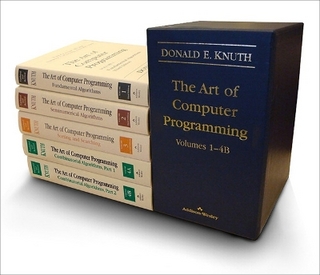
Analog and Digital Signal Processing
Delmar Cengage Learning
978-1-4180-4173-1 (ISBN)
- Titel ist leider vergriffen;
keine Neuauflage - Artikel merken
"Analog & Digital Signal Processing: A Computational Approach" provides a thorough yet mathematically accessible introduction to signal processing. With the increasing presence of digital signal processing (DSP) in everyday life, in the form of devices such as CD and DVD players, digital cameras, wireless telephones, and voice recognition, it has accordingly become a central element in the design of a variety of systems and applications. This book responds to this trend by presenting readers with a strong foundation of fundamental DSP concepts and designs. Unlike traditional DSP books, a computational approach is used to help readers spend less time deciphering mathematical complexities and more time implementing practical DSP techniques. MATLAB, an industry favorite scientific software package, is used to conduct the computations of the concepts discussed.
With coverage of introductory concepts such as sampling, frequency analysis, transfer functions, and filter design, as well as advanced topics like statistical signal processing, adaptive filters, image processing, and wavelet analysis, this is an ideal resource for readers of all levels who are seeking a comprehensive understanding of relevant DSP concepts for today's industry professionals.
Preface and Acknowledgments 1. An Introduction to Signal Processing 1.1. Some Signal Processing History 1.2. The Signal Processing System 2. Describing Signals 2.1. Representation of Signals 2.2. Classification of Signals 2.3. Mathematical Description of Specific Signals 3. Continuous-Time Systems and Discrete-Time Systems 4. The Frequency Domain of Digital Signals and Systems 4.1. The Discrete-Time Fourier Transform 4.2. Example Calculations with the Discrete-Time Fourier Transform 4.3. Effects of Signal Length and Windowing on the Discrete-Time Fourier Transform 4.4. The Discrete Fourier Transform 4.5. Inverse Transforms 4.6. Signal Power in the Time and Frequency Domains 4.7. Random Noise in Signals 4.8. The Frequency Response of a Linear Time-Invariant DSP System 5. Finite Impulse Response Filter Design 5.1. General Concepts of FIR Filter Design 5.2. Phase Distortion and Linear Phase 5.3. The Ideal Window Design Method 5.4. Sampling Design of FIR Filters 5.5. Optimal FIR Design Methods in MATLAB 6. Infinite Impulse Response Filter Design 6.1. The General Concepts of IIR Filter Design 6.2. Design by Pole-Zero Location 6.3. Digital Realization of Classical Analog Filters 6.4. MATLAB IIR Design Tools 6.5. Coefficient Quantization with IIR Filters 7. Over-Sampling and Multi-Rate DSP Systems 7.1. Digital Anti-Aliasing 7.2. Down-sampling and Decimation 7.3. Up-Sampling and Interpolation 7.4. Sampling Rate Conversion by Rational Factors 7.5. Over-Sampling and Noise 7.6. Delta-Sigma Quantization 8. Correlation and Auto-correlation of Signals 8.1. The Cross-Correlation of Signals 8.2. Auto-correlation 8.3. Using Auto-correlation to Detect Signals in Noise 8.4. Detecting and Ranging a Return Echo Contaminated with Noise 9. Adaptive Filters 9.1. Theory of Adaptive Filters 9.2. The Adaptive Predictor 9.3. Adaptive System Identification 10. Basic Digital Signal Processing of Images 10.1. The Structure of Digital Images 10.2. Image Sampling, Quantization, and Aliasing 10.3. Arithmetic Operations on Image Matrices 10.4. Statistical Properties and Enhancement of Images 10.5. Image Filtering 10.6. Discrete Fourier Transform of Images 10.7. Case Study: JPEG Compression of Images 11. Wavelets 11.1. Non-Stationary Signals 11.2. Sub-Band Decomposition and Reconstruction of Signals 11.3. Analysis of Signals Using Wavelets 11.4. Signal Compression Using Wavelets 12. Computational Case Studies 12.1. Dual-Tone Multi-Frequency Signaling 12.2. Pattern Recognition in Images 12.3. Speech Processing: Compression and Synthesis 12.4. Echo Cancellation with Adaptive Filters 12.5. Wavelet De-Noising and Compression of Images 12.6. Other Case Studies Appendices 1. Complex Numbers 1.1. Imaginary Numbers 1.2. Why We Need Imaginary Numbers 1.3. Complex Numbers 1.4. Polar Form of a Complex Number and Euler's Equation 1.5. Magnitude and Angle of a Complex Number 1.6. Complex Conjugate 1.7. Complex Exponential Forms of the Sine and Cosine Functions 1.8. Complex Functions 1.9. Working With Complex Numbers 2. A-to-D and D-to-A Conversion Methods 3. What Makes a DSP a DSP? 4. Mathematical Detail and Proofs 4.1. Fourier Analysis 4.2. The inverse DTFT 4.3. The inverse DFT 4.4. Statistical properties of digital signals: mean, variance, covariance, and expectation 4.5. The least-mean-squares algorithm to find the minimum of a function
| Erscheint lt. Verlag | 21.10.2007 |
|---|---|
| Verlagsort | Clifton Park |
| Sprache | englisch |
| Maße | 188 x 239 mm |
| Gewicht | 1206 g |
| Themenwelt | Mathematik / Informatik ► Informatik |
| Technik ► Elektrotechnik / Energietechnik | |
| Technik ► Nachrichtentechnik | |
| ISBN-10 | 1-4180-4173-4 / 1418041734 |
| ISBN-13 | 978-1-4180-4173-1 / 9781418041731 |
| Zustand | Neuware |
| Haben Sie eine Frage zum Produkt? |
aus dem Bereich


